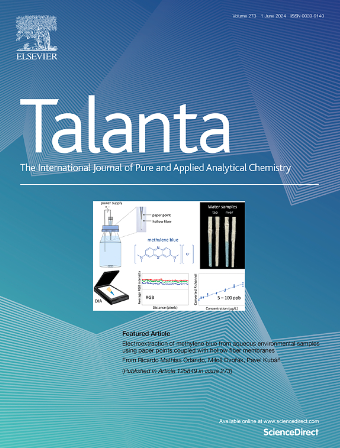改良QuEChERS萃取联用LC-MS/MS测定沉积物中全氟烷基和多氟烷基物质
IF 5.6
1区 化学
Q1 CHEMISTRY, ANALYTICAL
引用次数: 0
摘要
建立了一种改进的基于quechers的液相色谱-串联质谱法测定沉积物样品中25个单氟烷基和多氟烷基物质(PFAS)的方法。该方法的定量限为0.003 ~ 0.56 ng/g干重,日间精密度为0.3% ~ 16.2%,回收率为72% ~ 117%。通过对奥得河沿岸18个地点收集的沉积物进行分析,证实了该程序的适用性。检测到的14种PFAS总浓度在1.8 ~ 9.0 ng/g之间,生态风险有限。短链全氟羧酸,特别是C4是最丰富的,而长链全氟磺酸,包括C8,约占全氟磺酸总负荷的三分之一。新出现的PFAS,如ADONA和GenX,迄今为止在欧洲沉积物中几乎没有报道,在上游部分观察到更高的浓度。城市上游地区pH、TOC和Na+/K+水平的升高表明在城市流入之前存在人为影响。所选PFAS物种之间的强相关性表明它们有共同的来源,可能是工业排放或降解产物。PFAS的保留受环境参数的强烈影响,与TOC和电导率呈正相关,与ph负相关。分配分析证实,长链PFAS对沉积物具有更强的亲和力,支持沉积物作为长期环境汇的作用。所开发的分析程序,使用现代工具评估分析方法的环境可持续性,被评价为适度绿色,可以作为调查河流系统中PFAS分布和环境行为的有用方法。本文章由计算机程序翻译,如有差异,请以英文原文为准。

Modified QuEChERS extraction coupled with LC-MS/MS for the determination of per- and polyfluoroalkyl substances in sediments
A modified QuEChERS-based method combined with liquid chromatography–tandem mass spectrometry was developed for the determination of 25 per- and polyfluoroalkyl substances (PFAS) in sediment samples. The method achieved limits of quantification between 0.003 and 0.56 ng/g dry weight, inter-day precision ranging from 0.3 % to 16.2 %, and recoveries between 72 % and 117 %. The applicability of the procedure was confirmed through analysis of sediments collected from 18 sites along the Oder River. The total concentration of 14 detected PFAS ranged from 1.8 to 9.0 ng/g, indicating limited ecological risk. Short-chain perfluorocarboxylic acids, particularly C4, were the most abundant, while long-chain perfluorosulfonic acids, including C8, accounted for about one-third of the total PFAS burden. Emerging PFAS such as ADONA and GenX, which have been scarcely reported in European sediments to date, were detected, with higher concentrations observed in upstream sections. Elevated pH, TOC, and Na+/K+ levels upstream of urban areas suggest anthropogenic impact prior to city inflow. Strong correlations among selected PFAS species point to shared sources, likely industrial discharge or degradation products. PFAS retention was strongly influenced by environmental parameters, with positive correlations to TOC and conductivity, and a negative correlation to pH. Partitioning analysis confirmed that long-chain PFAS exhibit greater affinity for sediments, supporting the role of sediments as long-term environmental sinks. The developed analytical procedure, evaluated as moderately green using modern tools for assessing the environmental sustainability of analytical methods, may serve as a useful approach for investigating the distribution and environmental behavior of PFAS in riverine systems.
求助全文
通过发布文献求助,成功后即可免费获取论文全文。
去求助
来源期刊

Talanta
化学-分析化学
CiteScore
12.30
自引率
4.90%
发文量
861
审稿时长
29 days
期刊介绍:
Talanta provides a forum for the publication of original research papers, short communications, and critical reviews in all branches of pure and applied analytical chemistry. Papers are evaluated based on established guidelines, including the fundamental nature of the study, scientific novelty, substantial improvement or advantage over existing technology or methods, and demonstrated analytical applicability. Original research papers on fundamental studies, and on novel sensor and instrumentation developments, are encouraged. Novel or improved applications in areas such as clinical and biological chemistry, environmental analysis, geochemistry, materials science and engineering, and analytical platforms for omics development are welcome.
Analytical performance of methods should be determined, including interference and matrix effects, and methods should be validated by comparison with a standard method, or analysis of a certified reference material. Simple spiking recoveries may not be sufficient. The developed method should especially comprise information on selectivity, sensitivity, detection limits, accuracy, and reliability. However, applying official validation or robustness studies to a routine method or technique does not necessarily constitute novelty. Proper statistical treatment of the data should be provided. Relevant literature should be cited, including related publications by the authors, and authors should discuss how their proposed methodology compares with previously reported methods.
 求助内容:
求助内容: 应助结果提醒方式:
应助结果提醒方式:


